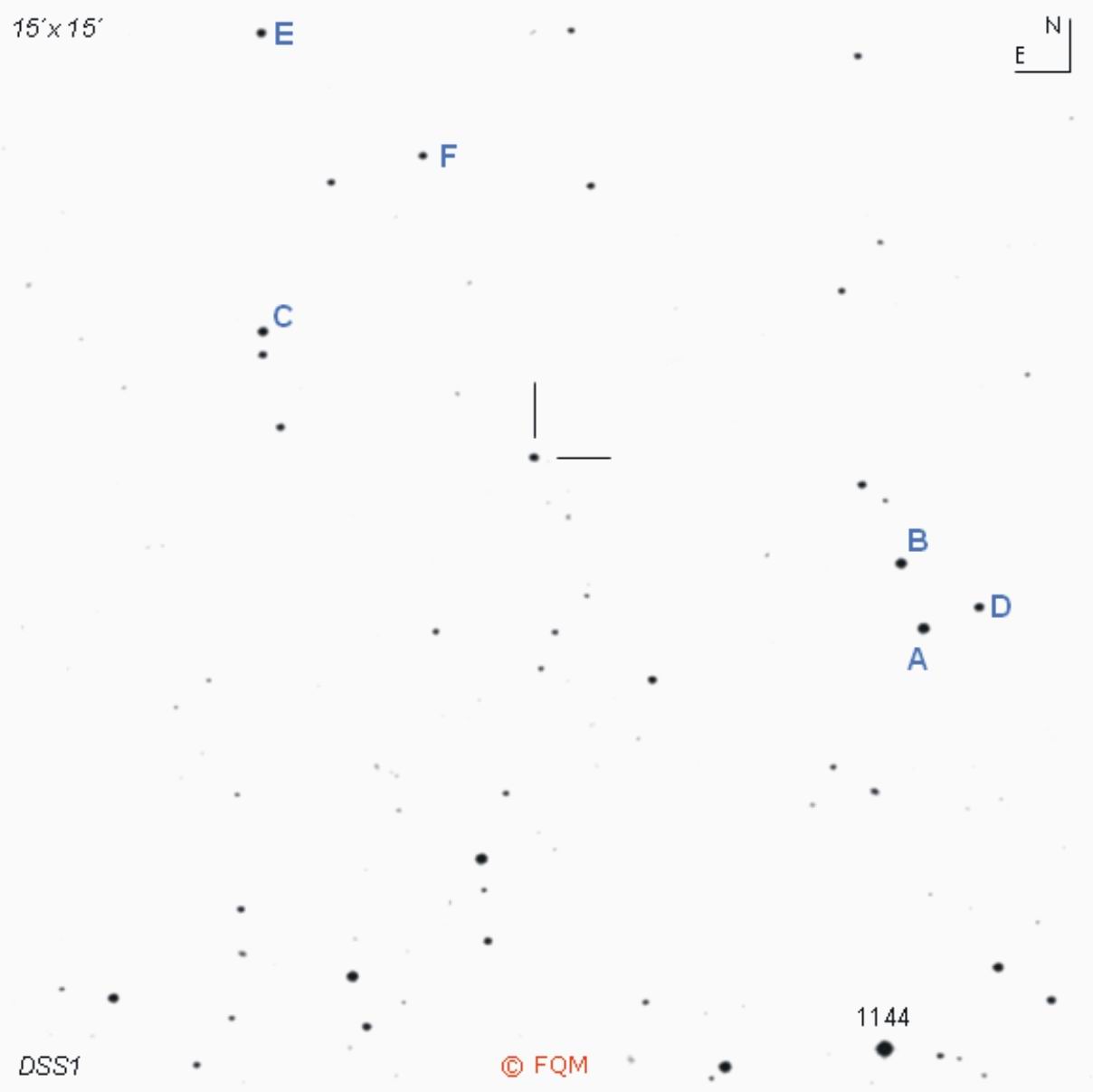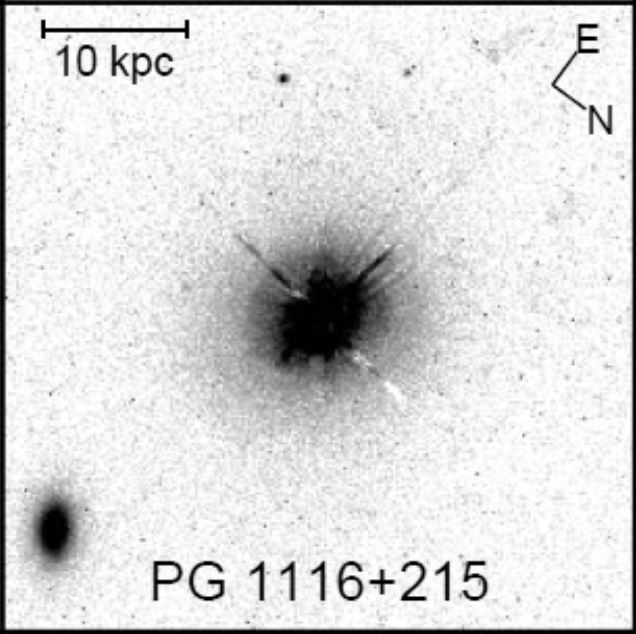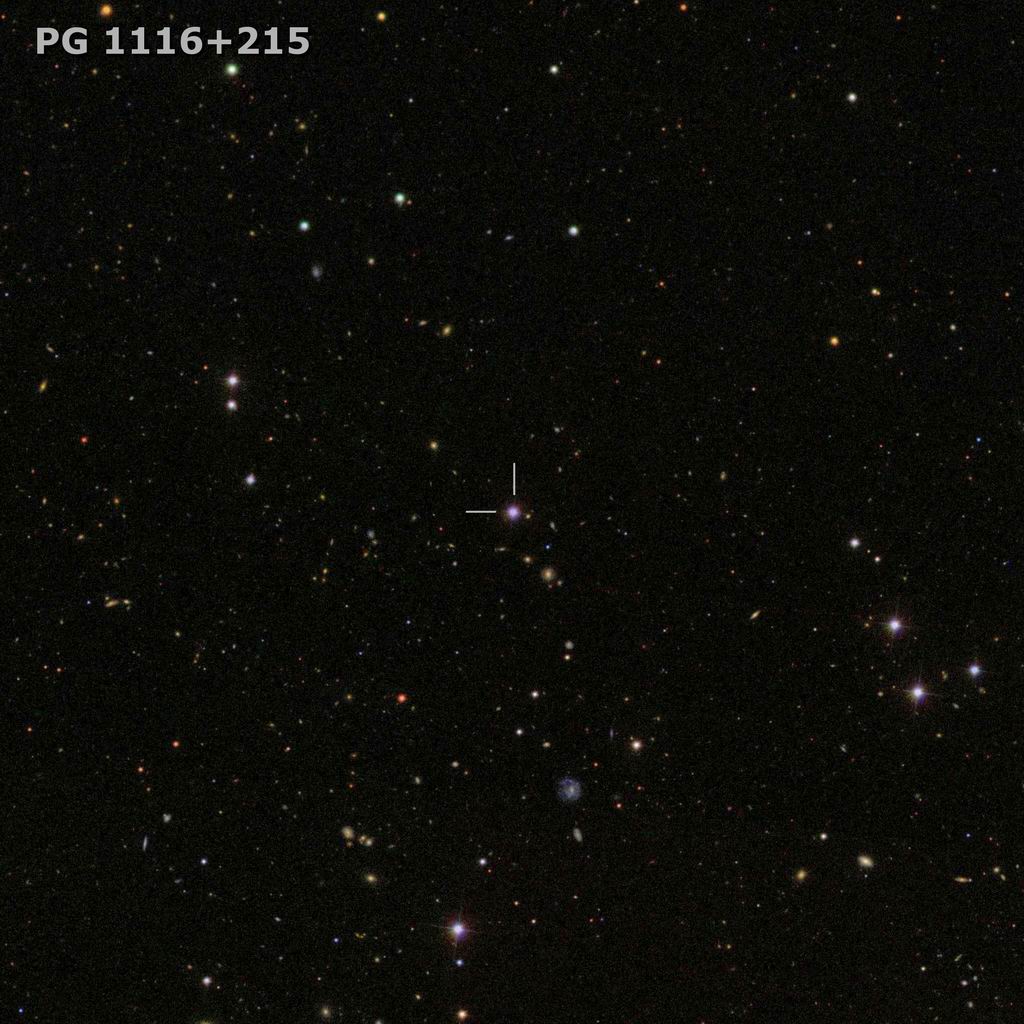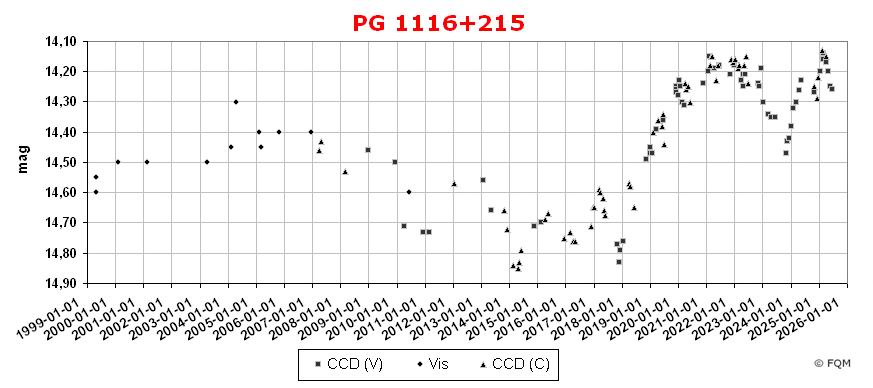
| Frankfurt Quasar Monitoring |
| PG 1116+215 |
| Cross-Identifications | EUVE J1119+21.3, 2MASSi J1119086+211918 1XMM J111908.7+211918, 2EUVE J1119+21.3 RX J1119.1+2119, 1RXS J111908.1+211915 FIRST J111908.6+211917, TON 1388, 2E 2443 SDSS J111908.67+211918.0, 1116+215 |
| Equat. coordinates | RA 11 19 08.8 DE +21 19 18 (J2000) |
| Constellation | Leo |
| Type | QSO |
| Redshift |
z=0.177 |
| Distance (2) (3) |
702 Mpc |
| Total mag range (mv) (4) | 14.2 - 15.0 |
| Catalog Magnitude (1) | 14.72 |
| Absolute Magnitude (1) | -25.3 MB |
| Light Travel-Time (2) | 2.110 × 109 yrs |

Comparison stars
| star | B | V | R |
| A | 14.22 | 13.47 | 13.14 |
| B | 14.50 | 13.77 | 13.37 |
| C | 15.12 | 14.34 | 13.93 |
| D | 15.16 | 14.49 | 14.15 |
| E | 15.64 | 14.71 | 14.28 |
| F | 16.18 | 15.46 | 14.98 |



| PG 1116+215 is a bright quasar in western Leo, only 1.4° NE of Delta
Leonis. The
designation PG:1116+215
derives from Palomar-Green Bright Quasar Survey
(PG), where this object was identified as a blue stellar object. Follow-up
spectroscopy led to the quasar classification (Seyfert 1-spectrum). Initially,
PG 1116+215
was discovered in the late 1950s by mexican
Tonantzintla Blue Stellar Objects Survey (TON), searching for blue
stellar objects like white dwarfs and quasars.
PG 1116+216 = TON 1388 was cataloged as a very blue object with a photographic magnitude of 14.5. In
the late 1990s, Hubble Space Telescope identified the quasar host as a
type E2 elliptical galaxy (see image above). PG 1116+215 is a small amplitude variable with a total range of about 1 magnitude in the optical. Visual observers with telescopes of 8- to 10-inch of aperture and larger will track down this 14-mag quasar without difficulties. PG 1116+215 appears as a stellar object even in large aperture telescopes. CCD observers, as well as visual observers, may use the comparison stars given above. No photometric sequence has been published to date. ____________
In case you look for another bright quasar you may turn
to PG
1211+143,
a bright 14-mag quasar at a distance of about 1×109
light-years, 15° SE of PG 1116+215. Turning your telescope 7.6° to the ENE will lead you to B2 1147+24, a highly variable BL Lac object, about 2.3×109 light-years distant. When you are around for PG 1116+215 just take a while and move your telescope 1.2° to the SE to visit pretty bright Sc-spiral NGC 3646. Images show its spiral arms strongly disturbed, resulting in a ring-like spiral arm pattern. Only 7´ to the NE, there is another galaxy, NGC 3649, which is probably responsible for the disturbances in NGC 3646, due to former gravitational interaction. About 1.5° NW of quasar PG 1116+215 we find a very special object: Leo II (UGC 6253, DDO 93), a Milky Way satellite galaxy. This dwarf spherical is a low surface brightness galaxy at a distance of roughly 800:000 light-years from earth. Deep widefield CCD imaging will easily catch this faint and large object (15´×:12´). Visual observers may also like to take a look at two loose galaxy groups in western Leo. The NGC:3607-galaxy group (3° S) and the NGC 3684-galaxy group (4.6° SE). Finally, rich galaxy cluster Abell 1367 (6° ESE), with its cD-galaxy NGC 3842, is an attractive (digital) observing target, you shall not miss. |
| Bahcall, J.N., Kirhakos, S., et al. 1997, ApJ, 479, 642; Hubble Space Telescope images of a sample of 20 nearby luminous quasars. Boroson, T.A., Green, R.F. 1992, ApJS, 80, 109; The emission-line properties of low-redshift quasi-stellar objects. Bowen, D.V., Osmer, S.J., Blades, J.C., et al. 1994, AJ, 107, 461; Hubble Space Telescope faint object spectrograph QSO absorption snapshot survey (ABSNA). Chavira, E. 1959, BOTT, 18, 3; Estrellas azules en el Casquete Galactico Norte - II. Elvis, M., Wilkes, B.J., McDowell, J.C., et al. 1994, ApJS, 95, 1; Atlas of quasar energy distributions. Giveon, U., Maoz, D., et al., 1999, MNRAS, 306, 637; Long-term optical variability properties of the Palomar-Green quasars. Green, R.F., Schmidt, M., Liebert, J. 1986, ApJS, 61, 305; The Palomar-Green catalog of ultraviolet-excess stellar objects. Hansen, T. 1991, Deep Sky Magazine 34, 32; The "Deepest" Deep Sky Objects. Karge, S.; Helle Quasare für 8- bis 10-Zoll Teleskope. Ein Beobachtungsführer zur visuellen Beobachtung von Quasaren und BL Lacertae Objekten; Frankfurt 2005. Schmidt, M., Green, R.F. 1983, ApJ, 269, 352; Quasar evolution derived from the Palomar bright quasar survey and other complete quasar surveys. Steinicke, W.; Katalog heller Quasare und BL Lacertae Objekte; Umkirch 1998. Véron-Cetty, M.-P., Véron, P. 2001, A&A 374, 92; A Catalogue of Quasars and Active Nuclei: 10th edition. Véron-Cetty, M.-P., Véron, P. 2003, A&A 412, 399; A Catalogue of Quasars and Active Nuclei: 11th edition. Véron-Cetty, M.-P., Véron, P. 2006, A&A 455, 776; A Catalogue of Quasars and Active Nuclei: 12th edition. Véron-Cetty, M.-P., Véron, P. 2010, A&A 518, 10; A Catalogue of Quasars and Active Nuclei: 13th edition. Wilkes, B.J., Kuraszkiewicz, J., Green, P.J., et al. 1999, ApJ, 513, 76; Investigation of the Relation between the Spectral Energy Distributions and the Emission Lines in Low-Redshift Quasars. |
| Link: |
| home |